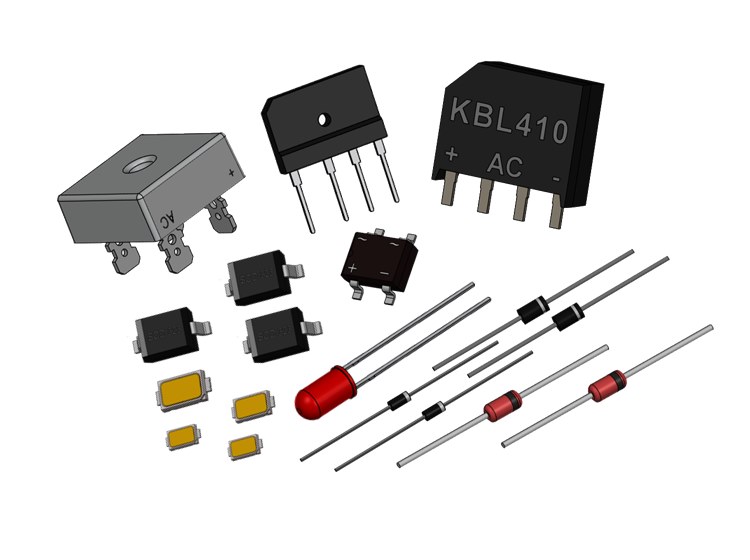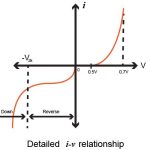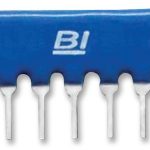Diodes are electronic components functions as a one-way valve it means it allow current to flow in one direction. These diodes are manufactured by the semiconductor materials germanium, silicon and selenium. Operation of diode can be classified in two ways, if it allows the current then it is forward biased otherwise it is reverse biased.
For silicon diodes the forward voltage is 0.7v and for germanium it is 0.3v. In silicon diode the dark band indicates the cathode terminal and the other terminal is anode. Generally diodes are used as reverse polarity protector and transient protector. There are many types of diodes and some of these are listed as follows.
1. Small Signal Diode
It is a small device with disproportional characteristics and whose applications are mainly involved at high frequency and very low currents devices such as radios and televisions etc. To protect the diode from contamination it is enveloped with a glass so it is also named as Glass Passivated Diode which is extensively used as 1N4148.
The appearance of signal diode is very small when compared with the power diode. To indicate the cathode terminal one edge is marked with black or red in color. For the applications at high frequencies the performance of the small signal diode is very effective.
With respect to the functional frequencies of the signal diode the carrying capacity of the current and power are very low which are maximum nearly at 150mA and 500mW.
The signal diode is a silicon doped semiconductor diode or a germanium doped diode but depending up on the doping material the characteristics of the diode varies. In signal diode the characteristics of the silicon doped diode is approximately opposite to the germanium doped diode.
The silicon signal diode has high voltage drop at the coupling about 0.6 to 0.7 volts so, it has very high resistance but low forward resistance. On other hand germanium signal diode has low resistance due to low voltage drop nearly at 0.2 to 0.3 volts and high forward resistance. Due to small signal the functional point is not disrupted in small signal diode.
2. Large Signal Diode
These diodes have large PN junction layer. Thus the transformation of AC to DC voltages is unbounded. This also increases the current forward capacity and reverse blocking voltage. These large signals will disrupt the functional point also. Due to this it is not suitable for high frequency applications.
The main applications of these diodes are in battery charging devices like inverters. In these diodes the range of forward resistance is in Ohms and the reverse blocking resistance is in mega Ohms. Since it has high current and voltage performance these can be used in electrical devices which are used to suppress high peak voltages.
3. Zener Diode
It is a passive element works under the principle of zener breakdown. First produced by Clarence zener in 1934.It is similar to normal diode in forward direction, it also allows current in reverse direction when the applied voltage reaches the breakdown voltage. It is designed to prevent the other semiconductor devices from momentary voltage pulses. It acts as voltage regulator.

4. Light Emitting Diode (LED)
These diodes convert the electrical energy in to light energy. First production started in 1968. It undergoes electroluminescence process in which holes and electrons are recombined to produce energy in the form of light in forward bias condition.
Earlier they used in inductor lamps but now in recent applications they are using in environmental and task handling. Mostly used in applications like aviation lighting, traffic signals, camera flashes.

5. Constant Current Diodes
It is also known as current-regulating diode or constant current diode or current-limiting diode or diode-connected transistor. The function of the diode is regulating the voltage at a particular current.
It functions as a two terminal current limiter. In this JFET acts as current limiter to achieve high output impedance. The constant current diode symbol is shown below.

6. Schottky Diode
In this type of diode the junction is formed by contacting the semiconductor material with metal. Due to this the forward voltage drop is decreased to min. The semiconductor material is N-type silicon which acts as an anode and the metal acts as a cathode whose materials are chromium, platinum, tungsten etc.
Due to the metal junction these diodes have high current conducting capability thus the switching time reduces. So, Schottky has greater use in switching applications. Mainly because of the metal- semiconductor junction the voltage drop is low which in turn increase the diode performance and reduces power loss. So, these are used in high frequency rectifier applications. The symbol of Schottky diode is as shown below.



